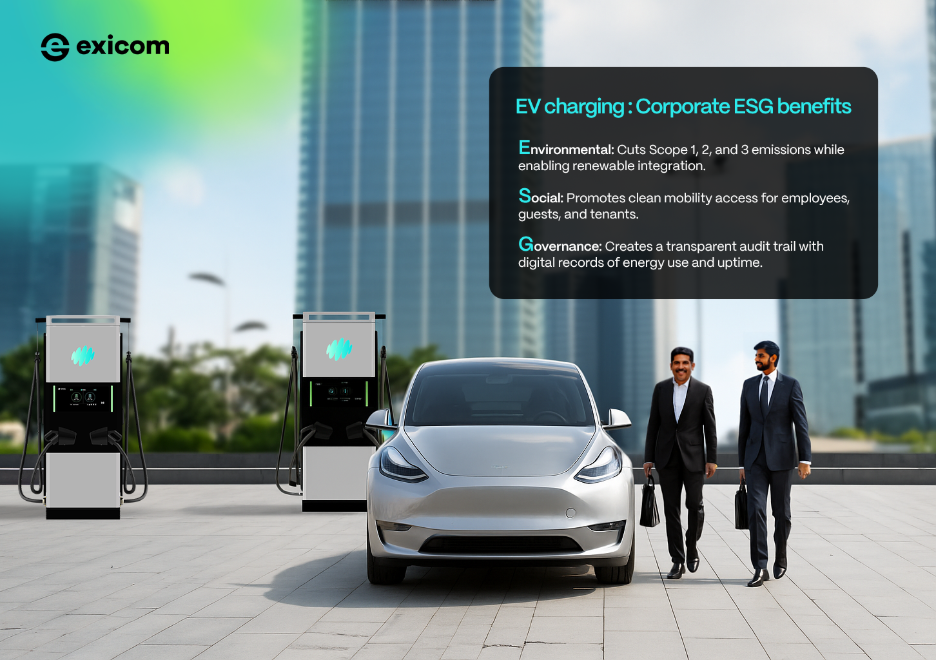How to improve ESG Ratings Through Smart EV Charging Solutions

As businesses, growth is our core focus. It should be. But as we spend years of effort gaining more ground, we must sometimes pause and think about what we’re doing to the very land we stand on. Climate change has actually made us see things we didn’t before. Conservationist Aldo Leopold once said, “We abuse land because we see it as a commodity belonging to us. When we see land as a community to which we belong, we may begin to use it with love and respect.” A business ecosystem cannot stand stable over a crumbling planet, which is why sustainability is becoming central to businesses. And that’s not all.
Having sustainability goals on paper is no longer enough. Investors, regulators, and rating agencies now demand proof. In our last blog, we talked about the kind of impact sustainability disclosures can have on a company’s financials, including stock prices. Today is a continuation of that story, as we dive specifically into ESG (environmental, social, governance) becoming a business KPI.
ESG Metrics Influence Business Prospects
It's now established that ESG is no longer a ‘good to have.’ It now has an effect on everything from getting capital to how the assets are valued.
Companies with a good ESG performance attract more investors as it’s a low-risk deal if other factors of business are in favor. This lowers their Weighted Average Cost of Capital (WACC), which means a higher worth of their business.
This change is getting even stronger because of financial instruments linked to ESG. Green bonds and sustainability loans, for example, make borrowing cheaper when they are tied to specific results, like lower carbon emissions or better energy efficiency.
In short, ESG excellence is now a way to make money, not just a way to follow the rules.
ESG Reporting is Becoming Mandatory for Businesses
India requires the top 1,000 listed companies to file a Business Responsibility and Sustainability Report (BRSR). It sets standards for ESG disclosure that are in line with international frameworks like GRESB and CDP.
The SEBI BRSR Core framework has increased ESG’s credibility. It has helped make ESG something that can be checked and verified.
SEBI Has Made BRSR Core KPIs Mandatory Already
This is done by SEBI by setting some important KPIs like energy, ethics, climate, water, diversity, and social responsibility. It also requires that the data reported be independently verified.
Companies now have to report their Scope 1 and 2 emissions, as well as verifiable information about employee welfare and efforts to stop corruption.
There are other new KPIs which even include social metrics like the number of jobs created in small towns or the pay women get.
The Full Disclosure Will Become Mandatory by FY 26
SEBI has deferred value-chain disclosure requirements (Scope 3 data) to FY 2026, which gives businesses some time to adapt. However, reporting will still be mandatory for key suppliers or partners that contribute 2% or more of procurement or sales.
Even social metrics like job creation in small towns or wages paid to women are part of the new KPIs.
The message is clear - vague sustainability claims are out, audited ESG proof is in. In short, your ESG readiness will soon depend on your enterprise ecosystem, not just your core service.
While SEBI BRSR is mandatory, it is not the only regulatory consideration If your company is speaking to a global investment audience.
CDP is the world's largest reporting standard
CDP its more than 800 investors representing US $95 trillion in assets. It’s important to pass the following criteria in it’s framework:
- Climate Change
- Water security
- Forests
- Plastics
- Biodiversity
But here’s a big question. If your company operates from a building that isn’t ESG-compliant, how will your own sustainability score hold up? This accountability falls equally on the real estate developers and facility owners for integrating sustainable infrastructure to support tenant disclosures.
GRESB Report is Important from a Real-Estate Standpoint
For developers and asset owners in the commercial space, frameworks like GRESB and CDP are critical to global recognition.
GRESB (Global Real Estate Sustainability benchmarks) audits energy use, greenhouse gas emissions, water consumption, waste management, and certifications for the building.
From a business standpoint, real estate has become a central pillar of ESG performance. Buildings account for a large share of corporate operational costs, so their sustainability profile directly impacts a company’s overall ESG rating. As a result, real estate portfolios with high ESG scores command higher valuations and access to global green capital, making them strategic assets for corporates aiming to enhance both sustainability and financial performance.
Many ESG Initiatives Are Loss Making and Hard to Report
Not all sustainability initiatives make financial sense in the short term.
High upfront CapEx, complex execution, and unclear ROI often deter decision-makers. Many ESG programs fail because leadership teams lack integration of know-how and digital reporting systems. Even though strong ESG performance can lower equity costs, it sometimes raises debt costs due to higher disclosure transparency.
The key is finding initiatives that are capital-efficient, data-verifiable, and ESG-impactful, and that’s where EV charging infrastructure shines.
EV charging is a profitable initiative with easy to report ESG benefits
EV charging infrastructure offers tangible, auditable ESG benefits across all three pillars:
- Environmental: Cuts Scope 1, 2, and 3 emissions while enabling renewable integration.
- Social: Promotes clean mobility access for employees, guests, and tenants.
- Governance: Creates a transparent audit trail with digital records of energy use and uptime.
Take GRESB’s scoring model, for example. It now distinguishes EV charging energy use from building energy consumption, so your increased electricity consumption due to EV charging doesn’t hurt your sustainability score.
Integrating EV charging and solar-powered infrastructure helps developers meet these stringent building benchmarks and earn LEED points under the “Green Vehicles” credit.

It’s an ESG initiative that’s profitable, reportable, and regulatory-ready.
How? Let’s take each metric and look at how EV charging fares in it.
EV Charging directly reduces Scope 1 emissions from company fleet
Scope 1 covers direct emissions, like fuel used in company fleets. By electrifying corporate vehicles and installing on-site EV chargers, companies can eliminate these emissions entirely. For example, transitioning a 100-car fleet from petrol to EVs can reduce carbon output by over 150 tons annually. This metric directly enhances BRSR Core compliance.
EV Charging powered by solar energy reduces Scope 2 emissions
Scope 2 covers purchased electricity. Even though EV charging increases electricity use, pairing chargers with solar panels or green power purchase agreements offsets this increase. Smart chargers with solar-powered EV charging ENERGY STAR efficiency can further cut standby energy consumption by up to 40%.
EV Charging can also reduce Scope 3 emissions by supporting EV adoption
Scope 3 is often the largest emission category as it also includes employee commuting and customer travel.Offering EV charging at offices, retail centers, or business parks incentivizes EV adoption and quantifiably reduces Scope 3 emissions.
Granular data, like session energy use and grid intensity, make this impact measurable for ESG disclosure.
These 3 benefits can be reported using smart charging protocols
Smart charging systems automatically log every session — energy use, uptime, CO₂ offset - into auditable, timestamped datasets. These can directly feed into BRSR, GRI, or GRESB frameworks, removing guesswork from ESG reports. Most modern platforms even generate auto-synced dashboards with real-time Scope 2 and 3 mapping, which typically is a compliance manager’s dream. Plus, integration with ISO 27001-certified APIs ensures secure, transparent reporting.
EV Charging Aligns with UN Sustainable Development Goals
EV charging doesn’t just meet corporate KPIs, it supports global impact goals as well:
- SDG 7: Affordable and Clean Energy
- SDG 9: Industry, Innovation, and Infrastructure
- SDG 11: Sustainable Cities and Communities
- SDG 13: Climate Action
By investing in EV-ready campuses or smart charging networks, companies help India accelerate its clean mobility transition while boosting their ESG narrative globally.
Here’s How to Implement EV Charging with ESG Reporting
Implementing EV charging is not just about infrastructure — it’s about aligning sustainability actions with measurable ESG outcomes. A structured roadmap ensures compliance, transparency, and investor confidence.
Step 1: Conduct ESG Materiality Mapping
Start by identifying where your biggest emission impact lies. For most businesses, it’s Scope 3 emissions from employee commuting, logistics, or vendor transport, often over 70% of the total footprint.An ESG materiality assessment helps prioritize what matters most to stakeholders and business impact.
This process often reveals that EV charging is a high-impact decarbonization lever, enabling measurable reductions in Scope 1 and 3 emissions while supporting upcoming BRSR and SEBI disclosure requirements.
Step 2: Design for Compliance and LEED Integration
Compliance starts at the design stage. The MoHUA mandates that 20% of parking spaces in new projects must be EV-ready, which means early electrical load provisioning, conduits, and space allocation. To meet standards, chargers must comply with ARAI AIS 138 for both AC and DC systems.
EV-ready design can also boost sustainability ratings under LEED v4.1, projects can earn points by installing chargers in 2% of parking spaces or making 6% EV-ready. Such infrastructure not only ensures compliance but also improves a property’s green valuation and tenant appeal, positioning developers for future ESG-linked funding.
Step 3: Choose Smart, Auditable Chargers
Smart chargers do more than power vehicles — they act as data collection points.
They record critical details such as energy consumption (kWh), timestamped sessions, and power source tracking, confirming whether electricity came from renewables or the grid. This data supports CDP and GRESB reporting and enables accurate Scope 2 and 3 calculations.
Choose systems with Open APIs and ISO 27001-certified security for safe integration with ESG dashboards.
When combined with solar or green power purchase agreements, smart EV chargers provide auditable proof of renewable energy usage, which is a major advantage for sustainability disclosures.
Step 4: Leverage Data Analytics for Continuous Improvement
Once chargers are operational, data analytics turns them into a real-time ESG tool.
Advanced platforms can:
- Optimize load distribution and shift charging to off-peak hours.
- Generate automated reports linking usage data to CO₂ offsets and Scope 2/3 metrics.
- Track asset utilization to identify underused stations or capacity gaps.
erified data simplifies annual disclosures and proves tangible environmental impact to auditors and stakeholders. This real-time visibility boosts transparency and investor trust, ensuring every charging session contributes to measurable ESG value.
EV charging has now transformed from just a facility add-on into a valuable, strategic ESG asset. By integrating smart charging infrastructure with verifiable data analytics, Indian corporates can report and improve their sustainability impact.
At Exicom, we help companies future-proof their sustainability journey through our smart EV chargers. Discover the perfect fit for your business here.
Frequently Asked Questions
Lorem ipsum dolor sit amet, consectetur adipiscing elit, sed do eiusmod tempor incididunt ut labore et dolore magna aliqua. Ut enim ad minim veniam, quis nostrud exercitation ullamco laboris nisi ut aliquip ex ea commodo consequat. Duis aute irure dolor in reprehenderit in voluptate velit esse.
Lorem ipsum dolor sit amet, consectetur adipiscing elit, sed do eiusmod tempor incididunt ut labore et dolore magna aliqua. Ut enim ad minim veniam, quis nostrud exercitation ullamco laboris nisi ut aliquip ex ea commodo consequat. Duis aute irure dolor in reprehenderit in voluptate velit esse.
Lorem ipsum dolor sit amet, consectetur adipiscing elit, sed do eiusmod tempor incididunt ut labore et dolore magna aliqua. Ut enim ad minim veniam, quis nostrud exercitation ullamco laboris nisi ut aliquip ex ea commodo consequat. Duis aute irure dolor in reprehenderit in voluptate velit esse.
Lorem ipsum dolor sit amet, consectetur adipiscing elit, sed do eiusmod tempor incididunt ut labore et dolore magna aliqua. Ut enim ad minim veniam, quis nostrud exercitation ullamco laboris nisi ut aliquip ex ea commodo consequat. Duis aute irure dolor in reprehenderit in voluptate velit esse.
Lorem ipsum dolor sit amet, consectetur adipiscing elit, sed do eiusmod tempor incididunt ut labore et dolore magna aliqua. Ut enim ad minim veniam, quis nostrud exercitation ullamco laboris nisi ut aliquip ex ea commodo consequat. Duis aute irure dolor in reprehenderit in voluptate velit esse.



